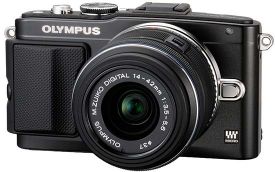TOPIC: OLYMPUS PEN E-PL5
A Look at a Compact System Camera
4th September 2013In August, I acquired an Olympus Pen E-PL5, and I'm still getting used to it. Its main appeal was combining SLR functionality with compact camera size. This was an upgrade from my Canon PowerShot G11 without the bulk of a larger camera.

When I considered Canon's EOS M before choosing the E-PL5, I was put off by its slow autofocus. The lack of a mode dial was another concern, though its APS-C sensor and price of around £399 were attractive (and I liked Canon's tendency to overexpose when examining images from an old Canon EOS 10D). After seeing a camera comparison in Practical Photography, I bought that issue. They preferred the similarly priced Olympus Pen E-PM2 over the Canon. Though a Panasonic won the test, I was interested enough in the Olympus to research further. Unlike the E-PM2 and EOS M, the E-PL5 has both a mode dial and extra grip, so I chose it despite the higher price. I had noticed discounted Olympus Pen models before, but this purchase was a more deliberate investment.
Breaking my usual preference for black cameras for variety's sake, I chose the silver E-PL5 from the three available colours (black, silver and white). The body is very compact, with the lens taking up most of the bulk. The standard 14-42 mm zoom means this isn't a shirt-pocket camera, so I bought a black Lowepro Apex 100 AW case. The case fits the camera snugly, making me wonder if I should have chosen a larger one, but it's working well. To protect the lens during outings, I also added a 37 mm Hoya HMC UV filter. The lens's plastic construction extends further than I expected and doesn't fully retract into its housing like some of my Sigma lenses.
On my first test run, I needed to work out how to hold the camera. My Canon PowerShot G11's powered zoom and autofocus made it more intuitive to hold, as was true for any SLR I've used. Holding the small body while adjusting the zoom lens was awkward at first. Eventually, I learned to steady the body with my right thumb (the curved thumb grip on the back holds a thumb vertically) while freely adjusting the lens with my left hand. An electronic viewfinder instead of the screen would have made things easier, but they're expensive, and I had already spent enough.
After learning to hold the camera, I needed to adjust to its exposure characteristics. From my experience, it tends to overexpose. Though I set it to store raw (ORF) files that can be fixed later, I prefer more control during capture. Also, I haven't found a spot or partial metering button like those on my SLR or G11. This means either using exposure compensation with aperture priority mode or switching to fully manual exposure. Other familiar modes are available (shutter priority, program, automatic, etc.). While getting familiar with the camera, I'm using bracketing after setting ISO to 400, increasing screen brightness and adding histograms to playback views. As my grip becomes more secure, I'm using the dial to adjust settings like aperture (f/16 remains my favourite despite what others think about micro four thirds sensor size) and compensation, keeping scenes consistent to test the camera's response to changes.
Though I'm still learning, I'm seeing pleasing results that encourage me to continue; some remind me of my Pentax K10D. The E-PL5 is slower to use than the G11, but that's often beneficial for photography. Being forced to slow down in our hectic world is another advantage. The G11 is seeing less use now, with sunny days offering chances for more experimentation and familiarisation. My introduction to compact system cameras has shown they're very different from compact fixed lens cameras or SLRs. Neither type is truly replaced; instead, a new category has emerged.